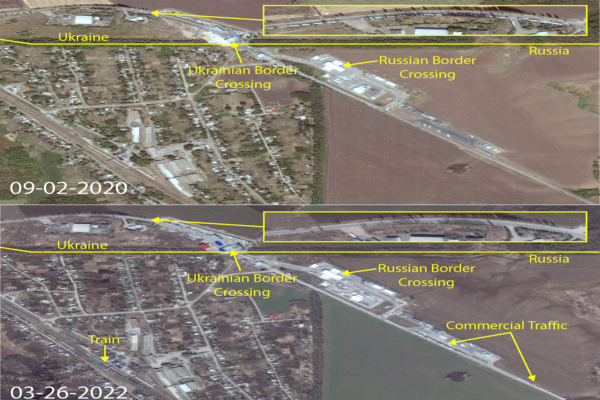AUSTIN, Texas — Russian state media has been significantly inflating the reported number of Ukrainian refugees entering the country, perhaps by as much as thousands a day. That’s the finding from the Global (Dis)Information Lab (GDIL), an interdisciplinary research lab at The University of Texas at Austin that recently released a new intelligence report on the subject. The report was completed in collaboration with the National Geospatial-Intelligence Agency (NGA) and used comparisons of commercial satellite imagery of border crossing and open reporting to reach its conclusions.
“Our analysis points to an effort on the part of the Russian state and state media to increase domestic support of this war by inflating the number of Ukrainian refugees reportedly accepted into Russia,” said Kiril Avramov, director of GDIL. “This helps the Kremlin to frame Russian speakers in Ukraine as innocent victims whose suffering justifies the Russian invasion and to encourage sympathy with the Russian cause.”
To investigate the veracity of Russian media claims that large numbers of Ukrainian refugees had fled across the Ukraine-Russia border, researchers compared satellite images of confirmed refugee border crossings from western Ukraine into Poland with images of the Ukraine-Russia border. They found significantly more refugee activity at the Poland border while images of Russian border crossings showed few civilian vehicles and a general lack of activity. The differences between the images of the two borders suggests that many fewer Ukrainians have sought refuge in Russia than Russian state media has reported. In their final report, the researchers concluded that the Russian government has probably spread inflated refugee numbers to present a positive image of the war to Russian citizens and to justify its operations in Ukraine.
“Original research — especially original research from imagery — is challenging,” said Christian Rasmussen, NGA Tearline program manager. “The biggest takeaway here is the ability to create something original that can be used in the Ukraine effort. The product is highly shareable internally and with our allies.”
The analysts reviewed the available imagery of the Matveev Kurgan border crossing in eastern Ukraine and found it showed about eight trucks and 10 cars queuing to enter Russia. Those vehicles could carry about 100 people in a day, the analysts estimated. However, the Russian border service has reported more than 16,000 refugees crossing into the country from the region including Matveev Kurgan in one 24-hour period. Even allowing for the presence of other crossing points in the area, the analysts found the Russian estimate to be significantly exaggerated.
Disinformation about Ukrainian refugees in Russia is unlikely to be limited to reports about border crossings. The researchers plan next to analyze claims from Russian state media about “temporary accommodation centers” the country has said it is using to house thousands of refugees. GDIL was unable to locate any likely locations for these centers before releasing its analysis of Ukrainian border crossings, but the analysts say potential locations for a few centers have since been identified, and they plan to investigate further for a following report.
GDIL’s research and analysis of Ukrainian-Russian border crossings were produced with input from and released through NGA’s Tearline project, which partners the agency with outside expert groups, and was conducted in part by undergraduate students at UT Austin. After publication, it was posted to Intel.gov’s main page and made the rounds in national intelligence circles.




